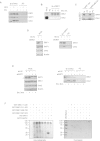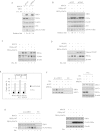Chk2 and REGγ-dependent DBC1 regulation in DNA damage induced apoptosis
- PMID: 25361978
- PMCID: PMC4245943
- DOI: 10.1093/nar/gku1065
Chk2 and REGγ-dependent DBC1 regulation in DNA damage induced apoptosis
Abstract
Human DBC1 (Deleted in Breast Cancer 1; KIAA1967; CCAR2) is a protein implicated in the regulation of apoptosis, transcription and histone modifications. Upon DNA damage, DBC1 is phosphorylated by ATM/ATR on Thr454 and this modification increases its inhibitory interaction with SIRT1, leading to p53 acetylation and p53-dependent apoptosis. Here, we report that the inhibition of SIRT1 by DBC1 in the DNA damage response (DDR) also depends on Chk2, the transducer kinase that is activated by ATM upon DNA lesions and contributes to the spreading of DNA damage signal. Indeed we found that inactivation of Chk2 reduces DBC1-SIRT1 binding, thus preventing p53 acetylation and DBC1-induced apoptosis. These events are mediated by Chk2 phosphorylation of the 11S proteasome activator REGγ on Ser247, which increases REGγ-DBC1 interaction and SIRT1 inhibition. Overall our results clarify the mechanisms underlying the DBC1-dependent SIRT1 inhibition and link, for the first time, Chk2 and REGγ to the ATM-DBC1-SIRT1 axis.
© The Author(s) 2014. Published by Oxford University Press on behalf of Nucleic Acids Research.
Figures






Similar articles
-
CCAR2/DBC1 is required for Chk2-dependent KAP1 phosphorylation and repair of DNA damage.Oncotarget. 2015 Jul 10;6(19):17817-31. doi: 10.18632/oncotarget.4417. Oncotarget. 2015. PMID: 26158765 Free PMC article.
-
DBC1 phosphorylation by ATM/ATR inhibits SIRT1 deacetylase in response to DNA damage.J Mol Cell Biol. 2012 Oct;4(5):294-303. doi: 10.1093/jmcb/mjs035. Epub 2012 Jun 26. J Mol Cell Biol. 2012. PMID: 22735644
-
hMOF acetylation of DBC1/CCAR2 prevents binding and inhibition of SirT1.Mol Cell Biol. 2013 Dec;33(24):4960-70. doi: 10.1128/MCB.00874-13. Epub 2013 Oct 14. Mol Cell Biol. 2013. PMID: 24126058 Free PMC article.
-
Cell cycle and apoptosis regulator 2 at the interface between DNA damage response and cell physiology.Mutat Res Rev Mutat Res. 2018 Apr-Jun;776:1-9. doi: 10.1016/j.mrrev.2018.03.004. Epub 2018 Mar 19. Mutat Res Rev Mutat Res. 2018. PMID: 29807573 Review.
-
REGgamma, a proteasome activator and beyond?Cell Mol Life Sci. 2008 Dec;65(24):3971-80. doi: 10.1007/s00018-008-8291-z. Cell Mol Life Sci. 2008. PMID: 18679578 Free PMC article. Review.
Cited by
-
Associations between proteasomal activator PA28γ and outcome of oral squamous cell carcinoma: Evidence from cohort studies and functional analyses.EBioMedicine. 2015 Jul 10;2(8):851-8. doi: 10.1016/j.ebiom.2015.07.004. eCollection 2015 Aug. EBioMedicine. 2015. PMID: 26425691 Free PMC article. Clinical Trial.
-
FadA promotes DNA damage and progression of Fusobacterium nucleatum-induced colorectal cancer through up-regulation of chk2.J Exp Clin Cancer Res. 2020 Sep 29;39(1):202. doi: 10.1186/s13046-020-01677-w. J Exp Clin Cancer Res. 2020. PMID: 32993749 Free PMC article.
-
SUMO1-regulated DBC1 promotes p53-dependent stress-induced apoptosis of lens epithelial cells.Aging (Albany NY). 2023 Sep 7;15(17):8812-8832. doi: 10.18632/aging.205001. Epub 2023 Sep 7. Aging (Albany NY). 2023. PMID: 37683133 Free PMC article.
-
Association between missense variants of uncertain significance in the CHEK2 gene and hereditary breast cancer: a cosegregation and bioinformatics analysis.Front Genet. 2024 Feb 27;14:1274108. doi: 10.3389/fgene.2023.1274108. eCollection 2023. Front Genet. 2024. PMID: 38476463 Free PMC article.
-
CCAR2/DBC1 is required for Chk2-dependent KAP1 phosphorylation and repair of DNA damage.Oncotarget. 2015 Jul 10;6(19):17817-31. doi: 10.18632/oncotarget.4417. Oncotarget. 2015. PMID: 26158765 Free PMC article.
References
-
- Shiloh Y., Ziv Y. The ATM protein kinase: regulating the cellular response to genotoxic stress, and more. Nat. Rev. Mol. Cell Biol. 2013;14:197–210. - PubMed
-
- Buscemi G., Zannini L., Fontanella E., Lecis D., Lisanti S., Delia D. The shelterin protein TRF2 inhibits Chk2 activity at telomeres in the absence of DNA damage. Curr. Biol. 2009;19:874–879. - PubMed
Publication types
MeSH terms
Substances
LinkOut - more resources
Full Text Sources
Other Literature Sources
Molecular Biology Databases
Research Materials
Miscellaneous

